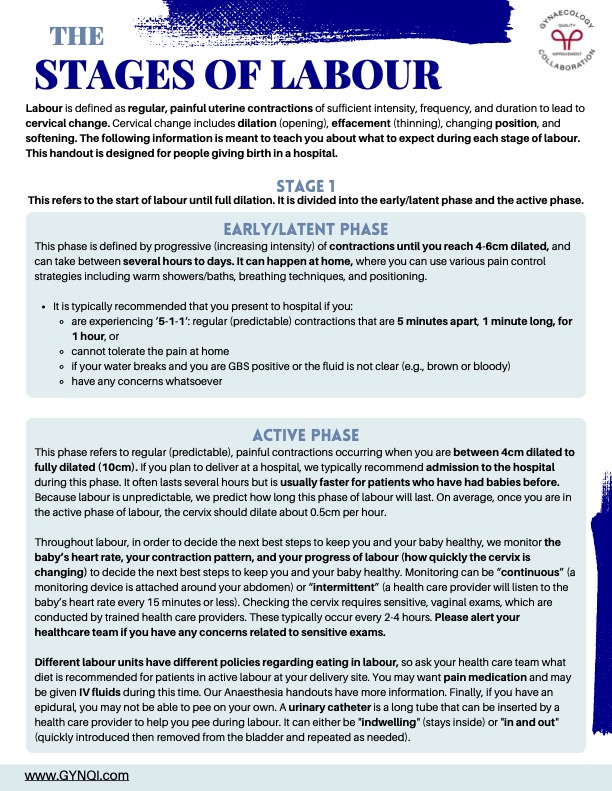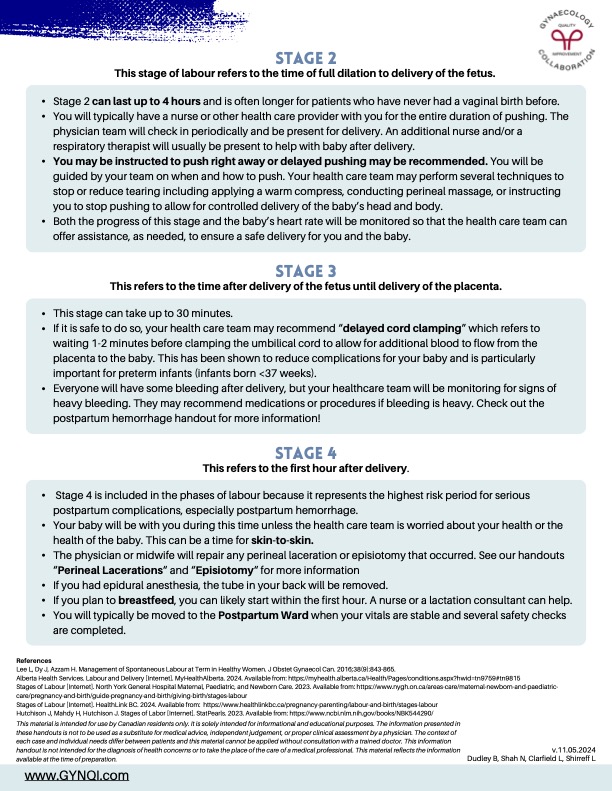The Stages Of Labour
Labour is defined as regular, painful uterine contractions of sufficient intensity, frequency, and duration to lead tocervical change. Cervical change includes dilation (opening), effacement (thinning), changing position, and softening. The following information is meant to teach you about what to expect during each stage of labour. This handout is designed for people giving birth in a hospital.
Stage 1
This refers to the start of labour until full dilation. It is divided into the early/latent phase and the active phase.
Early/Latent Phase
This phase is defined by progressive (increasing intensity) of contractions until you reach 4-6cm dilated, and can take between several hours to days. It can happen at home, where you can use various pain control strategies including warm showers/baths, breathing techniques, and positioning.
It is typically recommended that you present to hospital if you:
- are experiencing ‘5-1-1‘: regular (predictable) contractions that are 5 minutes apart, 1 minute long, for 1 hour, or
- cannot tolerate the pain at home
- if your water breaks and you are GBS positive or the fluid is not clear (e.g., brown or bloody)
- have any concerns whatsoever
Active Phase
This phase refers to regular (predictable), painful contractions occurring when you are between 4cm dilated to fully dilated (10cm). If you plan to deliver at a hospital, we typically recommend admission to the hospital during this phase. It often lasts several hours but is usually faster for patients who have had babies before. Because labour is unpredictable, we predict how long this phase of labour will last. On average, once you are in the active phase of labour, the cervix should dilate about 0.5cm per hour.
Throughout labour, in order to decide the next best steps to keep you and your baby healthy, we monitor the baby’s heart rate, your contraction pattern, and your progress of labour (how quickly the cervix is changing) to decide the next best steps to keep you and your baby healthy. Monitoring can be “continuous” (a monitoring device is attached around your abdomen) or “intermittent” (a health care provider will listen to the baby’s heart rate every 15 minutes or less). Checking the cervix requires sensitive, vaginal exams, which are conducted by trained health care providers. These typically occur every 2-4 hours. Please alert your healthcare team if you have any concerns related to sensitive exams.
Different labour units have different policies regarding eating in labour, so ask your health care team what diet is recommended for patients in active labour at your delivery site. You may want pain medication and may be given IV fluids during this time. Our Anaesthesia handouts have more information. Finally, if you have an epidural, you may not be able to pee on your own. A urinary catheter is a long tube that can be inserted by a health care provider to help you pee during labour. It can either be “indwelling” (stays inside) or “in and out” (quickly introduced then removed from the bladder and repeated as needed).
Stage 2
This stage of labour refers to the time of full dilation to delivery of the fetus.
- Stage 2 can last up to 4 hours and is often longer for patients who have never had a vaginal birth before.
- You will typically have a nurse or other health care provider with you for the entire duration of pushing. The physician team will check in periodically and be present for delivery. An additional nurse and/or a respiratory therapist will usually be present to help with baby after delivery.
- You may be instructed to push right away or delayed pushing may be recommended. You will be guided by your team on when and how to push. Your health care team may perform several techniques to stop or reduce tearing including applying a warm compress, conducting perineal massage, or instructing you to stop pushing to allow for controlled delivery of the baby’s head and body.
- Both the progress of this stage and the baby’s heart rate will be monitored so that the health care team can offer assistance, as needed, to ensure a safe delivery for you and the baby.
Stage 3
This refers to the time after delivery of the fetus until delivery of the placenta.
- This stage can take up to 30 minutes.
- If it is safe to do so, your health care team may recommend “delayed cord clamping” which refers to waiting 1-2 minutes before clamping the umbilical cord to allow for additional blood to flow from the placenta to the baby. This has been shown to reduce complications for your baby and is particularly important for preterm infants (infants born <37 weeks).
- Everyone will have some bleeding after delivery, but your healthcare team will be monitoring for signs of heavy bleeding. They may recommend medications or procedures if bleeding is heavy. Check out the postpartum hemorrhage handout for more information!
Stage 4
This refers to the first hour after delivery.
- Stage 4 is included in the phases of labour because it represents the highest risk period for serious postpartum complications, especially postpartum hemorrhage.
- Your baby will be with you during this time unless the health care team is worried about your health or the health of the baby. This can be a time for skin-to-skin.
- The physician or midwife will repair any perineal laceration or episiotomy that occurred. See our handouts “Perineal Lacerations“ and “Episiotomy“ for more information
- If you had epidural anesthesia, the tube in your back will be removed.
- If you plan to breastfeed, you can likely start within the first hour. A nurse or a lactation consultant can help.
You will typically be moved to the Postpartum Ward when your vitals are stable and several safety checks are completed.





